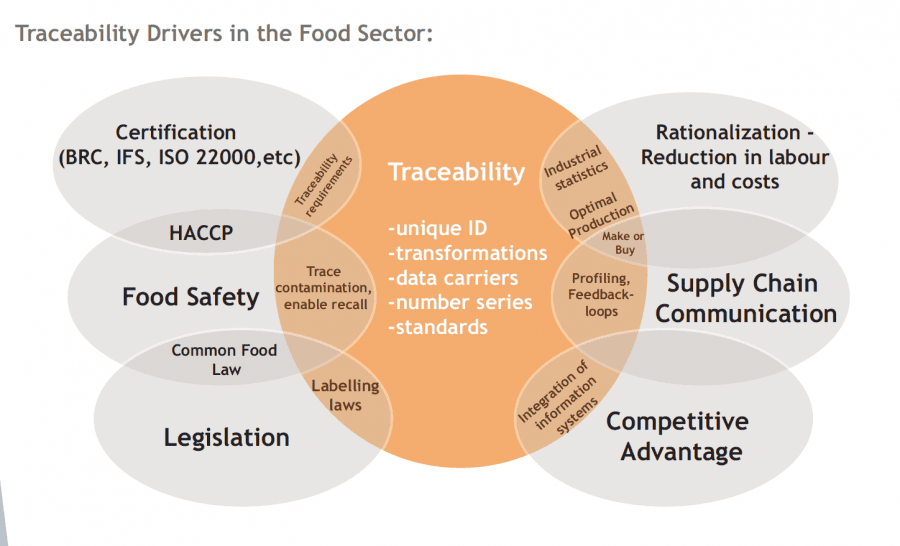How the New ‘Safe Food For Canadians’ Act will affect the Food Industry
Achieving and maintaining full compliance of government and industry regulations is still one of the greatest concerns of companies in the Food and Beverage industry. Subject to various regulations established by governing bodies, businesses devote considerable resources to attaining full compliance to existing norms, but these continue to change.
The manner in which a business manages its response to changing regulations impacts the effect that the new regulations have in disrupting, or improving, business operations. By examining current changes to regulations and understanding the objectives these changes are trying to accomplish, a business can better position itself to deal with new standards that
have an industry wide impact while preparing for future requirements currently under development. This flexible attitude is a necessity for a business looking to gain competitive advantages to remain profitable in an increasingly competitive business environment.
This paper will offer an overview to some of the significant changes that will be impacting the Food and Beverage industry with the introduction of the new Safe Food for Canadians Act as well as highlighting some changes to standards that are still to come. The Answer Company provides business management software systems, such as Enterprise Resource Planning (ERP) software specifically designed to address the increased demands for traceability imposed by the new regulations. This paper aims to explain these changes and their impact for business operations. Future papers will address how our solutions can help meet the demands of these regulations.
Overview of the Safe Food for Canadians Act
The Canadian federal government is currently in the process of improving Canada’s food safety system to better protect consumers. In an effort to strengthen and modernize current regulations, the government is consolidating the authorities of multiple food related statutes into a single Act. This Act, called the Safe Food for Canadians Act, aims to:
- Improve food safety, through consistent oversight across all food commodities and tougher prohibitions, penalties, and fines for activities that put health & safety at risk.
- Strengthen food traceability practices
- Provide better control over imports, including prohibiting the importation of unsafe food commodities
- Register or license regulated parties and establishments.
For food manufacturers, the Act brings several implications as it consolidates and addresses
shortcomings in four previously independent food-related statutes:
- Canada Agricultural Products Act (CAPA)
- Fish Inspection Act (FIA)
- Meat Inspection Act (MIA)
- Food-related provisions of the Consumer Packaging and Labeling Act (CPLA)
Currently, the inspection model covers different types of food commodities separately, those being dairy, eggs, meat, processed foods, imported and manufactured food, fish and seafood, fresh fruits, and vegetables. The new legislation will consolidate the government’s authority in regulating practices of companies involved in food and beverage industry under a single inspection model.
Changes to Inspection Practices
The Safe Food for Canadians Act puts forth new inspection regulation and sets the tone for more transparency, monitoring and control of food manufacturers over ingredients used for food-related products. By consolidating the authority over food commodities, the federal government is looking to streamline inspection processes into a consolidated and consistent approach, in addition to incorporating available advanced technologies into the legislation. To better protect consumers,
Inspectors will have the ability to inspect all food commodities, instead of being limited to only one area. For example, previously an Inspector assigned to meats had to send another Inspector to review an issue with produce, while the new Act allows one Inspector to review all food commodities. Also, the new authority to make warrant requests by telephone will allow Inspectors the ability to request a new or additional warrant while still on property and issue penalties on the spot instead of needing to return at a later date with a new warrant, avoiding granting time for companies to remove the infraction and avoid penalties. The new Act will also make it easier for Inspectors to pass through, or over, private property to get to a place for inspection purposes or to take photographs.
Other changes include granting Inspectors the power to request that an individual start or stop an activity to prevent non-compliance with the Act, the power to ask for documents to be produced, and the power to have any obstruction or interference removed that would result in the Inspector not being able to perform his or her duties.
Full Traceability
Traceability is the ability to follow an item, such as an ingredient, or a group of items such as animal, plant, or food products throughout the supply chain. There are currently many traceability requirements already in place, such as animal identification and components of movement reporting.
The legislation currently in place does not require food manufacturers to have a specific set of traceability systems. With the announcement of the Act, the CFIA gains the authority to develop new regulations related to tracking and recalling food, in other words, full traceability. This includes establishing requirements for the implementation of the appropriate tools to perform real or mock recalls of potentially unsafe food commodities. Companies will need to have systems in place that can locate ingredients or products that contain any specific component deemed unsafe, at any point in the supply chain. These traceability systems will also be used to ensure that food commodities that have been recalled are not resold, as items will be registered.
The main objective of a traceability system is to mitigate the risk of a harmful product from spreading to consumers. By implementing a national system, the government is aiming to safeguard consumers and the food supply while holding accountable those deemed responsible for bringing to customers unsafe food commodities. Through registering and tracking ingredients or products throughout the supply chain, companies can contribute to minimizing the risk by performing fast recalls and identifying the source of dangerous food commodities.
Document Production
Inspectors for the CFIA will have legal access to examine any document that is in an establishment containing products that are covered by this Act. In addition, Inspectors will be able to access computer systems or any other device present in such establishments. This measure was already present in previous legislation, but in consolidating inspection authority, the legislation grants wider reach to government inspections.
Document production includes lists of ingredients, origin of ingredients, formulations and methods of manufacture, and labels (which are to not be misleading as to the nature of quality, composition, character, safety, value, variety, or origin of food product).
Food Imports and Exports
The Safe Food for Canadians Act aims to increase the safety of consumers by licensing and registering importers, and the establishments where food commodities are destined to arrive. This means that businesses must have, within their systems, records of all establishments and what items they will be receiving. Businesses will also be accountable and responsible for ensuring that any food commodities they bring into the country is safe for consumers. The idea here is to protect the reputation of Canadian food manufacturers, should any incident occur. By recording and monitoring importers, the federal government will be able to pinpoint those responsible for unsafe products or ingredients that affect Canadian consumers.
The Act also gives greater control over the production and importation of food commodities by enabling the federal government to determine conditions, and contingencies, for licenses & registrations. This means that different importers will have to comply with the different conditions attached to their specific license and registration, and these will be reviewed periodically in accordance with factors determined by the Canadian government. The licensing and registration also allows the government to act quicker and more aggressively should importers not comply.
On the other side of the trade exchange, through the Act, the CFIA gains the ability to certify all food commodities for export with the goal of helping Canadian businesses more readily compete on the global stage. This stems from other countries’ governments, including Canada’s main trading partner, the United States (with $33 billion in total bilateral trade in 2010), demanding that the originating country certify imported food commodities. In fact, this portion of the Act is a clear move towards aligning Canada’s regulation with that implemented by the Food Safety Modernization Act in the United States, and thus validating the quality of commodities to be exported to that county.
Registering and Licensing Establishments
Registration and licensing are methods that have positive results in addressing non-compliance of safety standards. As it currently stands, the CFIA licenses persons and registers establishments for activities that relate to specific food commodities. Under the new Act, the CFIA will be able to use licensing and registration for all food commodities, which means that a single license will encompass all food related activities performed by a person or an establishment, eliminating the need for various licenses related to different food products.
Additional licenses will not be needed for other activities or products due to the simplified and single authority granted to Inspectors by the new Act. Each establishment will provide information about their business, such as management’s commitment to meeting regulations, preventative control plans, assurance that key personnel have completed food handling training, and which products will be produced under different processes.
Collecting and organizing this information will help the CFIA develop a profile of companies, including how they conduct business and a base of knowledge for different food sectors. After determining inherent risk for each food sector, the level of supervision and conditions of licensing will be defined.
Compliance Now and in the Future
The consolidation of legislations through the Safe Food for Canadians Act is an attempt to generate greater consistency in industry requirements. In efforts to better reflect current conditions and future trends of the Food and Beverage industry, the government is reinforcing its commitment to food safety by setting out a single set of rules that strongly communicates, not only to industry members but to the global market as well, that Canada has a strict, straightforward, and proactive compliance standards when it comes to food safety. Changes in government regulations like the ones presented here offer well prepared businesses an opportunity for competitive advantage. The federal government’s commitment to food safety for consumers is a clear indication of where the regulatory environment is heading: towards investment in new technologies that automate safeguards when it comes to the manufacturing and preparation of food commodities. Stricter supervision and inspections along with increased power for, and amount of, penalties directly places the burden on businesses to match regulatory bodies’ expectations of safety standards. Businesses that take a proactive approach towards investing in such technologies will be better positioned to deal with upcoming changes currently in the works and future regulations to be implemented in the industry.
Companies in the Food and Beverage industry that are looking to export products will benefit from having the government certify food commodities. This will raise Canada’s profile and standards in the international arena, saving businesses from having to invest in proving the safety of their product themselves.
Process manufacturers that adopt and implement traceability systems will not only witness the operational benefits from having ingredients and products traced (such as data compilation and intelligence analysis into internal operations) but also will better align their food safety objectives with those of governing bodies.
As changes to regulations have substantial effects on the bottom line of all industry members, those that make the move to adapt early. For information on information systems that can provide some of the functionalities needed to address these new regulatory concerns, please visit stage.theanswerco.com or call 604-473-9166.

